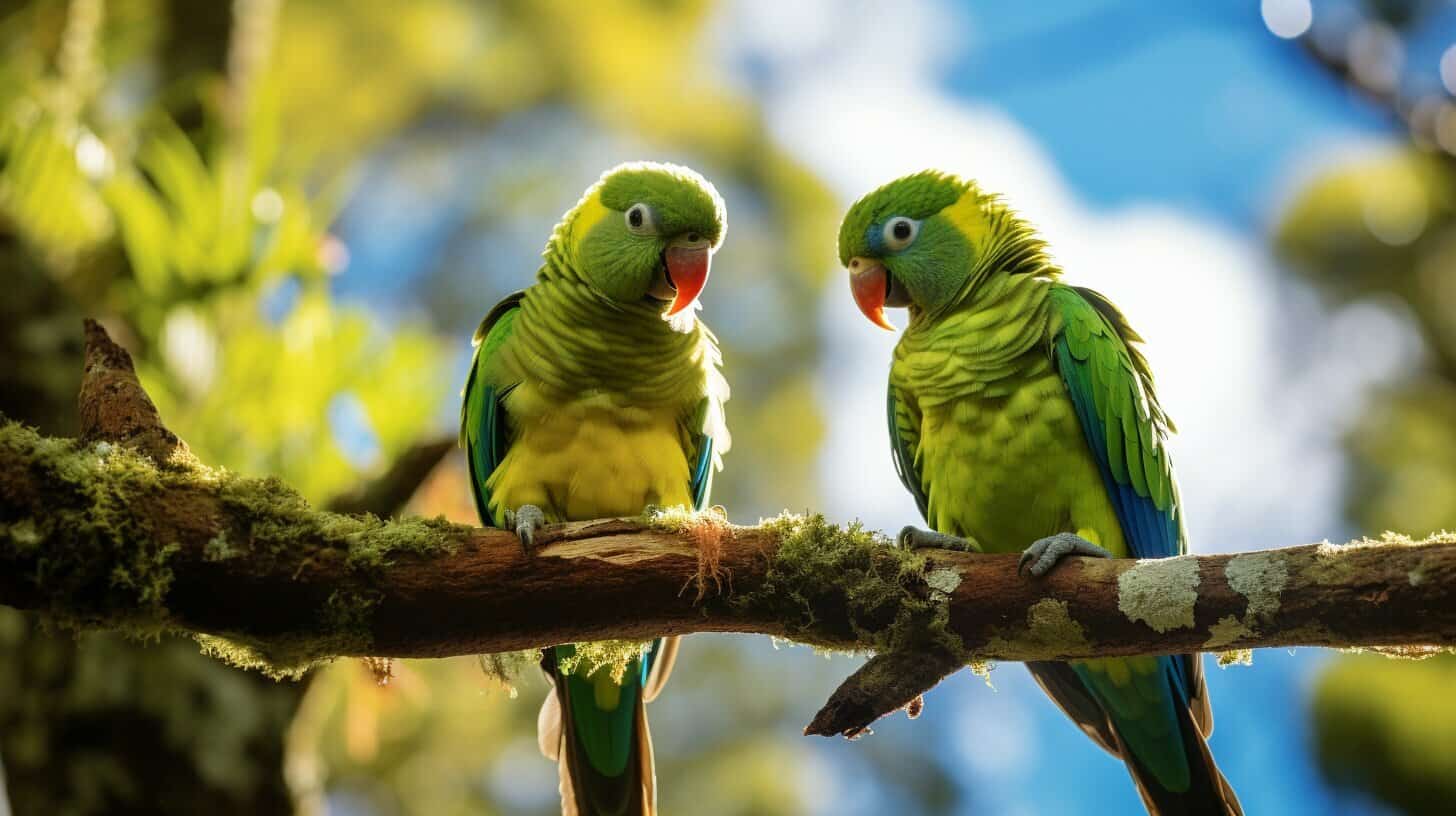Kakarikis are an intelligent and sociable species popular among pet owners. These small parrots are known for their vibrant colouration and playful personalities, but their breeding habits are often a topic of discussion among enthusiasts and bird lovers alike.
One of the most frequently asked questions about kakarikis is whether they mate for life. In this article, we will explore the breeding behaviour of kakarikis and provide insights into their mating habits.
Do Kakarikis Mate for Life? Kakarikis, in general, do not mate for life. Though these parakeets may form strong bonds with their partners for a particular breeding season or several years, they don’t necessarily stay with the same mate throughout their lives. It’s common for Kakarikis to switch partners under different circumstances or if one mate perishes.
Key Takeaways:
- Kakarikis are popular pet birds known for their vibrant colouration and playful personalities.
- This article explores whether kakarikis mate for life and delves into their breeding behaviour and social habits.
- Topics covered include the breeding season, pair bonding, courtship behaviours, and the impact of taming on mating behaviour.
Understanding Kakariki Breeding Patterns
Kakarikis are known for their unique breeding patterns influenced by external factors such as climate and habitat. They primarily breed during the spring and summer, with breeding activity starting around September and ending in February.
During the breeding season, pairs of kakarikis will form, consisting of one male and one female. These pairs will bond closely and exhibit courtship rituals such as vocalizations, feeding, and preening each other. Pair formation is not necessarily for life, and individuals may find new mates in subsequent breeding seasons. However, the pairs can remain together for several breeding seasons.
Once paired, kakarikis tend to lay 4-7 eggs in a clutch, with an incubation period of approximately 19 days. After hatching, the chicks take around 30 days to fledge from the nest and become independent. Kakarikis can breed multiple times per year, but the number of clutches produced varies depending on environmental conditions and the overall health of the breeding pair.
Reproductive Patterns
Despite breeding with multiple partners and producing multiple clutches per year, kakarikis are known to be monogamous. This means that when paired, the male and female will remain loyal to each other throughout the breeding season. During this time, the male will provide food for the female and help incubate the eggs, while the female is responsible for most of the direct care of the chicks once they hatch.
In addition, research has suggested that kakarikis demonstrate a unique ability to adjust their reproductive output in response to environmental factors. For example, if conditions are unfavourable, such as during a drought or in an area with a low food supply, kakarikis may delay breeding until conditions improve.
Pair Formation
Kakarikis can form pairs in many ways. In some cases, pairs may form through a specific hierarchy of dominance within a group, with the dominant male and female pairing off. In other cases, pairs may form based on individual preferences and compatibility, with birds selecting their mates through courtship and bonding behaviours.
Additionally, captive kakarikis have been observed to form pairs with their human caregivers. While this may not be a natural behaviour, it suggests that kakarikis can form close bonds with various individuals, regardless of species.
Overall, the breeding patterns of kakarikis are complex and adaptable, allowing them to reproduce successfully in various environments. Whether forming lifelong pair bonds or adjusting their reproductive output in response to changing conditions, these birds demonstrate a remarkable ability to adapt and thrive.
The Lifespan of Kakarikis and Their Mating Habits
Kakarikis live up to 15 years in the wild, and with proper care, they can live up to 20 years in captivity. See our post What is the Lifespan of a Kakariki?
Age may play a role in a bird’s ability to mate, with younger birds being more fertile and active in seeking mates than older birds.
While there is no definite answer as to whether or not kakarikis mate for life, they exhibit monogamous behaviour and often form close bonds with their chosen partners. In the wild, pairs of kakarikis will mate for the breeding season and may choose to mate again in the following years if their first attempt is successful.
However, kakarikis may be kept in pairs or colonies in captivity, which can affect how they mate. Pairs in captivity may choose to stay together for life, while birds kept in colonies may bond with different birds during each breeding season.
It is important to note that taming kakarikis may impact their mating behaviour. Tamed birds may exhibit different breeding patterns and may even form bonds with humans instead of other birds.
Overall, while there is no definitive answer to whether or not kakarikis mate for life, they exhibit monogamous behaviour and form close bonds with their chosen partners. Their breeding habits may differ in captivity, and taming may impact their mating behaviour, highlighting the complex nature of these fascinating birds.
Kakariki Courtship and Mate Selection
Kakarikis have fascinating courtship behaviours and bond through various social interactions with their mates. These birds typically form lifelong pair bonds but do not necessarily mate for life, as some may switch partners between breeding seasons.
The courtship rituals of kakarikis involve various vocal and physical displays. Males perform elaborate courtship dances to impress potential mates, fluffing their feathers and wagging their tails while displaying their brightly coloured plumage. They also emit loud, repetitive calls to attract females and establish their territory.
Female kakarikis, in turn, show their interest by responding to the males’ calls and displays and by engaging in mutual preening, a behaviour that reinforces their bond and affection.
Kakariki Breeding
Once a pair of kakarikis has formed, they will begin breeding during the mating season between August and February. These birds typically lay up to eight eggs per clutch (see our post How Many Eggs Do Kakarikis Lay? for more details), which hatch after an incubation period of around three weeks. The chicks are cared for by both parents and become independent after about six weeks.
Interestingly, kakarikis may form colonies to breed, where multiple pairs may breed close to each other. However, this behaviour is less common, and most kakarikis prefer to pair together to breed and raise their offspring.
Mate Selection
While the exact mechanism of mate selection in kakarikis is not fully understood, it is thought that birds may choose their partners based on various factors such as vocalization patterns, physical appearance, and courtship displays. Recent studies have also shown that birds may prefer mates with similar personalities and behavioural traits.
“Kakarikis have a complex social structure and show remarkable social intelligence. Mate selection is an important aspect of their breeding behavior, and it can have a significant impact on the success of their offspring.”
Kakarikis are fascinating birds with complex social behaviours and intriguing breeding habits. Their courtship displays, mate selection, and pair bonding make them a joy to observe and study.
Colony Breeding vs. Pair Bonding in Kakarikis
Kakarikis exhibit different breeding strategies depending on their habitat and ecological conditions. In their natural habitat, they tend to form colonies of breeding pairs that share a communal nesting site and raise their offspring cooperatively. This strategy, known as colony breeding, offers several advantages to kakarikis, including increased defence against predators, sharing of food resources, and improved mating opportunities.
However, kakarikis tend to form pair bonds and mate exclusively with their chosen partner when kept in captivity. Pair bonding promotes a stronger emotional attachment between individuals and increases the likelihood of successful breeding and offspring rearing. It also reduces competition and aggression among individuals and allows the breeder to better monitor individual health and reproductive success.
Although kakarikis can pair bond, they are not guaranteed to stay with the same partner for life. Factors such as age, health, and availability of suitable mates may influence their mating decisions and lead to the formation of new pair bonds. Nevertheless, pair bonding is a crucial aspect of kakariki reproduction and should be encouraged by providing suitable nesting sites, perches, and other environmental stimuli that promote bonding and breeding behaviour.
Taming Kakarikis and its Impact on Mating Behavior
Many kakariki owners wonder whether taming their birds can affect their mating behaviour, and the answer is not straightforward. While tamed birds may exhibit different behaviours than their wild counterparts, it is unclear whether this affects their breeding patterns.
One potential impact of taming kakarikis is that they may become more social and less aggressive towards humans. This can increase the willingness to mate in captivity, as they feel more comfortable in their environment. Tamed birds may also be more likely to accept a mate their owner chose rather than selecting their pairing.
However, taming can also have negative effects on kakarikis’ breeding behaviour. Domesticated birds may lose their instincts to build nests and select appropriate mates, leading to unsuccessful reproduction. Additionally, if tamed birds are not provided with appropriate perches, they may not engage in courtship or display proper breeding behaviours.
To ensure successful breeding in tamed birds, providing them with a suitable environment that mimics their natural habitat is important. This includes offering different types of perches, such as wooden or rope perches, and providing them with nesting materials. Owners should also be aware of the potential risks of taming, such as the loss of natural behaviours and instincts, and take measures to counteract these negative effects.
While taming may impact kakarikis’ mating behaviour, the extent of this impact is not fully understood. It is important for owners to provide a suitable environment and to monitor their birds’ behaviour to ensure successful reproduction.
Conclusion
Overall, kakarikis are fascinating birds with complex breeding behaviours. While it is often believed that they mate for life, research suggests that they may form long-term pair bonds but can also engage in colony breeding and may choose new partners.
Their breeding season typically occurs during the warmer months, and pairs form based on various factors such as age, genetics, and environmental cues. Kakarikis exhibit courtship behaviours that involve vocalizations, displays, and grooming, and they choose mates based on physical appearance, behaviour, and compatibility.
The availability of suitable perches and nesting sites is crucial for successful breeding, and taming can impact their mating behaviour. While tamed birds may exhibit different patterns, providing them with the right environment to fulfil their reproductive needs is essential.
Overall, understanding the intricate mating habits of kakarikis can help provide them with adequate care and create a conducive environment for breeding. While they have a reputation for monogamy and lifelong love, their social behaviours and breeding strategies are more complex than initially thought.
FAQ
Q: Do Kakarikis mate for life?
A: Kakarikis do not mate for life. While they may form long-term pair bonds during breeding seasons, they do not necessarily stay with the same partner for life.
Q: What are the breeding patterns of Kakarikis?
A: Kakarikis have a specific breeding season, usually during spring and summer. They form pairs for breeding and exhibit reproductive patterns such as courtship displays, nest-building, and egg-laying.
Q: How long do Kakarikis live, and what are their mating habits?
A: Kakarikis have an average lifespan of 10 to 15 years. When it comes to mating habits, while they may form pairs during breeding seasons, they do not necessarily exhibit lifelong monogamy.
Q: How do Kakarikis engage in courtship and choose their mates?
A: Kakarikis engage in courtship behaviour, including head-bobbing, wing-flapping, and vocalizations. They choose their mates based on these courtship displays and social interactions.
Q: Do Kakarikis engage in colony breeding or pair bonding?
A: Kakarikis are known to engage in pair bonding rather than colony breeding. They tend to form pairs with one partner, although they may occasionally stray or switch partners.
Q: Does taming Kakarikis affect their mating behaviour?
A: Taming Kakarikis may impact their mating behaviour, as tamed birds may exhibit different breeding patterns. Providing suitable perches and nesting materials is crucial for their reproductive needs.
Further Reading



Have comments or questions about this article? Then get involved!
Spotted an error or something we have missed? Let us know